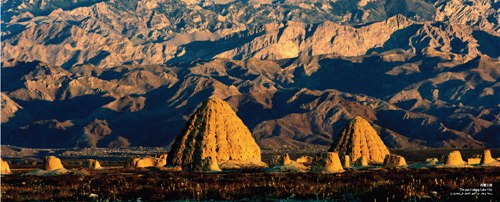|
 |
|
(FILE) |
People come to China to visit the Great Wall and gaze at the Forbidden City in wonder but very few are aware of other marvels waiting to be explored just two hours away from Beijing, the capital, by flight.
If you have a day or two to spare, come to Ningxia, the "land of the Oriental pyramids."
Located in northwest China, the Ningxia Hui Autonomous Region whose capital Yinchuan is a green delight reclaimed from desolate desert sand, is a storehouse of history, being the site of an ancient advanced civilization.
A line of Xia kings ruled the desert kingdom of Xixia (1038-1227) that stretched over today's Ningxia and parts of its neighboring provinces. A mighty race of riders, the Xias held their own against powerful kings from the Song, Liao and Jin dynasties during those days. However, the dynasty was overthrown by the Mongols under Genghis Khan (1162-1227).
Though capital Khara-Khoto, meaning "Black City" in Mongolian language, revived under the new rulers, it was destroyed again in the 14th century when the Song army clashed with the Mongols and the former diverted the Black River, the lifeline of the city. The city was abandoned and claimed by the desert.
Nine of the Xia kings were buried in elaborate underground tombs that were like miniature cities, complete with an inner city, four watch towers at four corners, and a temple meant for sacrifices, despite the Xia kings being Buddhists. One had a walled-in library of scrolls.
The tombs were discovered when foreign explorers, mainly Russians, began explorations in the region. They were dug up by grave robbers, marauding armies and explorers. The buried treasures vanished. Later, explorers like Russian Pyotr Kuzmich Kozlov (1863-1935) and Hungarian-British Sir Marc Aurel Stein (1862-1943) carted away priceless ancient manuscripts, sculptures and other artefacts to their own country.
However, they could not take away the Buddhist towers – stupas – that were built over the tombs. Many of these still remain, despite erosion by the desert winds. These earth-colored inverted cone-like structures look like Egypt's pyramids. There are 270 such graves that have been discovered but they have all been sealed.
But the little museum on the way to the tombs is a treasure trove, giving a brief history of the Xia kingdom and offering glimpses into the exquisite art and developed civilization it had fostered. The region boasts 108 Buddhist pagodas and the museum has a most unusual image of the Buddha as the destroyer.
The mound that is part of the tomb of Li Yuanhao (1003-1048), the founder of the dynasty, was 40 meters high. Unfortunately, the buffeting wind and deepening sand have reduced it to just 21 meters. So visit this unique heritage of ancient human civilization when it is still there. Tomorrow could be too late.
(Reporting from Ningxia) | 